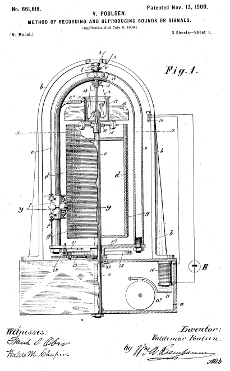The basis for magnetic tape development was set by Valdemar Poulsen by inventing the Telegraphon about 1890. With this Invention it was possible to save sound waves on a steel wire. Sure enough this could be called a first dictaphone. Surprisingly it last more than 30 years to get these invention ready for series production so the first porduct on the market was the Dailygraph released in 1928. The Dailygraph records and plays with 610 mm/s speed. To reach a capacity of on hour recording the wire has to be 2199 meter long. Because the wire was very thin it could easily be wind up on small inductors.

German companies like AEG and I.G. Farben(later:BASF) invested in the development of magnetic tapes since 1935. At the beginings they tried coated paper. This was the basis for further development in audio,video and data recording with magnetic tape. About 1950 magnetic tape was more and more used by information technologics. Famous kinds of magnetic tape are the Compact Cassete(1963) and the S-VHS(1987). People who possesed or do posses a walkman or a video recorder will know them very well. Nowadays magnetic tapes are mainly used in information technology because of their high reliability. Consumers can still find them in video cameras(MiniDV(1995)).

A typical handicap of magentic tapes is the Shoeshine Problem. Because tapes can only be accessed sequentially they have to be wind up and down many times. This is very stressfull to the mechanic structur of the read/write unit. To prevent this situation big buffers are used to create a continuous stream of data. More information can be found at Pros and Cons.